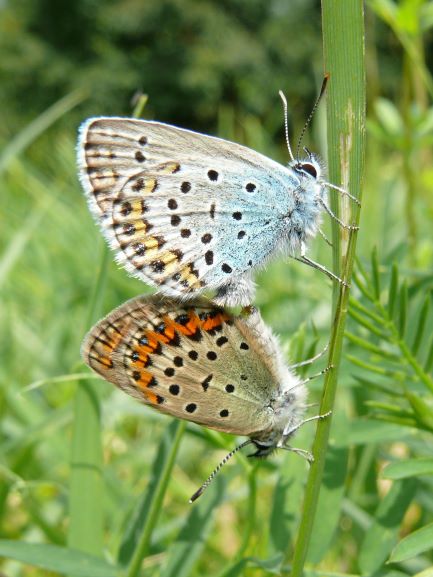
species of the week #2 – the northern blue
The nothern blue is characterized by a blue, metallic upper side and an orange stripe on the underside with a special spotted pattern. It lives on sunny, patchy overgrown neglected grassland and gravel soil. Its caterpillars eat mainly broom; hence the name.
The caterpillars of all bluebirds have developed different strategies to help them with ants. The caterpillars of the broom blues excrete a sweet secretion called honeydew, which ants like to eat. In return, the ants protect the caterpillars and bring them to their ant nest to pupate. The particularly rabid slave ants and the broom blue ants work most often together.
| Distribution status | extinct in Rhineland-Palatinate |
| Remaining deposits | Few animals near Karlsruhe and Munich |
| Last sightning in Rhineland-Palatinate | 1981 near Langenberg |
| Habitat | calcareous and acidic nutrient-poor grassland |
| Threat
|
Fertilization, scrub encroachment, eutrophication of the habitat |
The northern blu suffers from a large-scale decline of its habitat along with other blue-white species (such as Storkbeak Blue, Woundklee-Blue, Esparsette Blue, Striped Blue). All mentioned species prefer calcareous or acidic nutrient-poor grassland with patchy vegetation. The sunny, bare patches are the preferred habitat of ants and thus also of the Blue-blue. In the past, however, the nutrient fertilizer was often applied to the grasslands and they were transformed into fields or forests. The extensive abandonment of migratory shepherding often leads to scrub encroachment on the areas. Continuous fertilization from the air, especially from power plant and diesel exhaust fumes, enriches the soil with nitrogen, which changes the plant composition: “opportunists” grow faster when nitrogen is applied and displace “specialists” who can only assert themselves on nutrient-poor sites.
Almost half of the European butterfly species live on nutrient-poor grassland. For this reason, many conservationists are taking intensive care of the remaining areas.
Politically necessary:
– Effective measures to reduce nitrogen oxide emissions in the energy and transport sectors
– Stabilization of global warming
– agricultural subsidies for sustainable agriculture, biotope management and animal husbandry
– Support of the migratory shepherding
Photo:Blues, above: Male, below: female, photographer : Harald Süpfle
